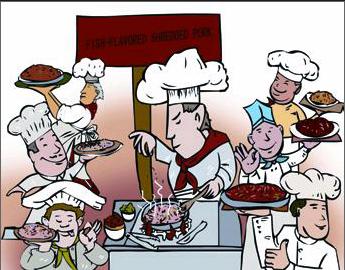Is It Reasonable to Set Standards For Sichuan Cuisine?
2015-12-14

The Administration of Quality and Technology Supervision of Sichuan Province recently set 12 standards for Sichuan cuisine. The standards not only cover well-known dishes such as fish-flavored shredded pork but also ingredients such as sausages. Although the standards are not mandatory, they have caused much controversy online. Some support the measures as they can help to standardize Sichuan cuisine and promote the development of Chinese cuisine chains and Chinese food culture, others believe the focus should be on food safety, while still others criticize the government departments use of standards on such things as meddling.
Good for large-scale production
Jiang Debin (China Youth Daily): If the standards are followed, the tastes of Sichuan cuisine will not vary too much from each other and the reputation of the cuisine can be safeguarded.
As Chinese cuisine lacks standardized cooking methods, its hard to guarantee the stability of the flavor of the dishes. As a result, the same dish may turn out to be vastly different in flavor when cooked by different chefs, and even by the same chef at different times. A lack of standards has made it difficult to develop chain restaurants of Chinese cuisine.
Although Chinese food has a good reputation, it is a pity that there are no famous, worldwide Chinese restaurant chains like McDonalds and KFC. Standardization of products is the foundation for large-scale production. Only by setting standards for different dishes can the Chinese catering industry realize large-scale operation.
Besides, the standards of Sichuan cuisine will not remain unchanged, but will be changed every three years following the demand of the market. Meanwhile, the standardization doesnt prohibit personal tastes and creativity. Restaurants can develop their own distinctive dishes based on the standards.
Liu Yijie (Xian Evening News): As a matter of fact, it has been common practice to set standards for the food industry. For instance, the national standards for wheat flour steamed buns were implemented nationwide in 2008.
Publishing standards for a certain type of cuisine is reasonable. It helps to prevent strange dishes such as corn fried with grapes from being made. Moreover, the current lack of standards has hindered Chinese cuisine from realizing industrial production, which would be beneficial to the economy.
Focus should be food safety
Mao Jianguo (Xinhua Daily Telegraph): Whether a kind of food is popular is not determined by whether they meet certain standards but by whether they are liked by customers. Standards which are too strict and detailed will only hinder the development and innovation of the catering industry.
It should be admitted that some food standards are necessary to prevent restaurants from cheating customers. For instance, some restaurants serve dishes which differ vastly from whats described on the menu and some dishes are unsafe.
To prevent this from happening, setting standards for dishes is reasonable. However, the standards should not be compulsory nor too detailed. They should be set targeting the most important procedures of food production and respect the creativity of chefs.
Standardization is beneficial to the development of the food industry and food safety. Nevertheless, as Chinese cuisine is not mass-produced on the production line, the government should not enforce too strict standards on it. In fact, stricter safety standards should be applied while the standards on cook-ing techniques and processing methods should be more relaxed.
Xiao Hua (Changjiang Daily): Setting standards for the methods of cooking seems unnecessary because even if there are such standards, it is hard for them to be implemented and regulated. For instance, the standards require the colors of certain dishes to be bright red. In reality, its hard to make objective judgment for the color of dishes as different people have different standards for the color of bright red.
Additionally, many dishes are constantly developing, and chefs change their methods of cooking or create new dishes over time. Setting standards for dishes may restrict innovation within Chinese commercial kitchens.
Moreover, the flavors of dishes should be adjusted according to the needs of the market. It is not the responsibility of a government department to set standards for dishes.
The government should return what should be managed by the market to the market and mind businesses within its scope of jurisdiction. It should be in charge of the quality and price of dishes rather than the flavors.
Leave it alone
Fu Keyou (Chengdu Economic Daily): This is an era of standardization. There are standards for home appliances, for fruits and vegetables. Standardization means that products can be mass-produced with the same standard. It greatly improves efficiency and enables companies to grab a larger market share. The success of McDonalds and KFC can be attributed to standardization to a large extent. As a result of standardization of the fast food chains, customers in a small city in China can eat hamburgers with the same taste as those in the United States. However, a lack of standards has restricted the development of Chinese cuisine. In order to break the restrictions, a series of standards for Chinese cuisine have been unveiled in recent years.
Setting standards for Sichuan cuisine represents the local governments efforts to protect and promote the cuisine. The standards have laid out special requirements for some brand Sichuan dishes in terms of cooking techniques, use of ingredients and cooking temperatures. Such standards can help improve chefs cooking abilities and the competitiveness of Sichuan cuisine at large.
However, had the standards been formulated by a trade association rather than a government department, they might not have stirred so much controversy. The department in question should be in charge of forming food safety standards rather than standards for cooking techniques.
Its impossible to apply the same standard to a Sichuan dish because different customers have different tastes. One can never taste the same kind of Sichuan dish with exactly the same flavor in two different restaurants. This is where the charm of Chinese cuisine lies.
Varieties are the sources of happiness. As the demand for personalized products rises, setting standards for Sichuan cuisine seems to be going against the trend.
Qu Zhengzhou (Western Economic Daily): Judged against the 12 standards, the most commonly cooked Sichuan dishes such as fish-flavored shredded pork may be unqualified. As different people have varied tastes, whether dishes cooked following the standards will be liked by customers is hard to say.
Standards for cooking methods serve to prevent and control risks in the food industry and promote the development of the industry at large. However, standards may have limited effect in promoting the development of the food industry as what customers pursue is unique flavors. Restaurants which are able to survive the fierce competitions depend on their unique ways of cooking. Finally, it is the customers who have the say in determining whether a dish is tasty rather than standards. Then why bind peoples hands and feet with standards?
Although the standards are not compulsory, the governments mindset of governance can be seen through the act of setting the standards. Certain government departments think that their supervision can be omnipresent and they can even guide the chefs to cook. The basic functions of the government under the market economy include providing public service, strengthening supervision over the market and maintaining fairness and order. If the government goes beyond these functions, it is bound to be criticized.
